RIPOSTE
by RIP RENSE |
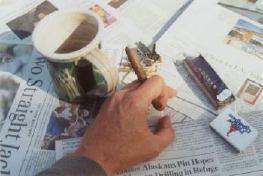
|
July 17, 2017
L' Kikki pour L'art
There is a type of bird common in
Central America, an unassuming little thing in chestnut and dark
brown called the Nightingale Wren. Marshmallow-sized, it hops around wood
and dale, minding its simple wren business, doing no harm. You wouldn’t pay
it the slightest attention except that every now and then, the whole of its
body puffs up to almost twice normal size, and the whole of its being is
poured into a song so lyrical, so arresting, as to make the little bird
utterly unforgettable.
This is the
artist, Kikki Eder.
She is
diminutive, presents nothing remarkable except perhaps to the keen-eyed, who
might sense her faculties. She speaks in a quiet, self-assured alto, hopping
around her home in Highland Park, minding her simple Kikki Eder business,
doing no harm.
But when she
sits at an easel, brush in hand, the whole of her being is poured into a
song so lyrical, so arresting, as to be utterly unforgettable.
“I don't want
my paintings to be an intellectual exercise. I want them to be an emotional
experience,” says Ms. Eder, with a hint of leftover Detroit from childhood.
You see?
Unassuming, straightforward. A one-time plein air artist,
plain-spoken, with no airs (she paints from photos, now.) Yet Eder’s stated
philosophy is inadequate description, too clinical by half. What must be
said up front is that her work stuns, whether you like it or not (and it’s
hard to imagine a reason to not, short of the caprices of
subjectivity.) These paintings sprout arms, grab you by the lapel, if you
have a lapel, pull you over and exhort, “Look! Look where you are! Look how
shockingly glorious everything really is! Remember! Even for a second or
two!”
At least they
do this for me.
|
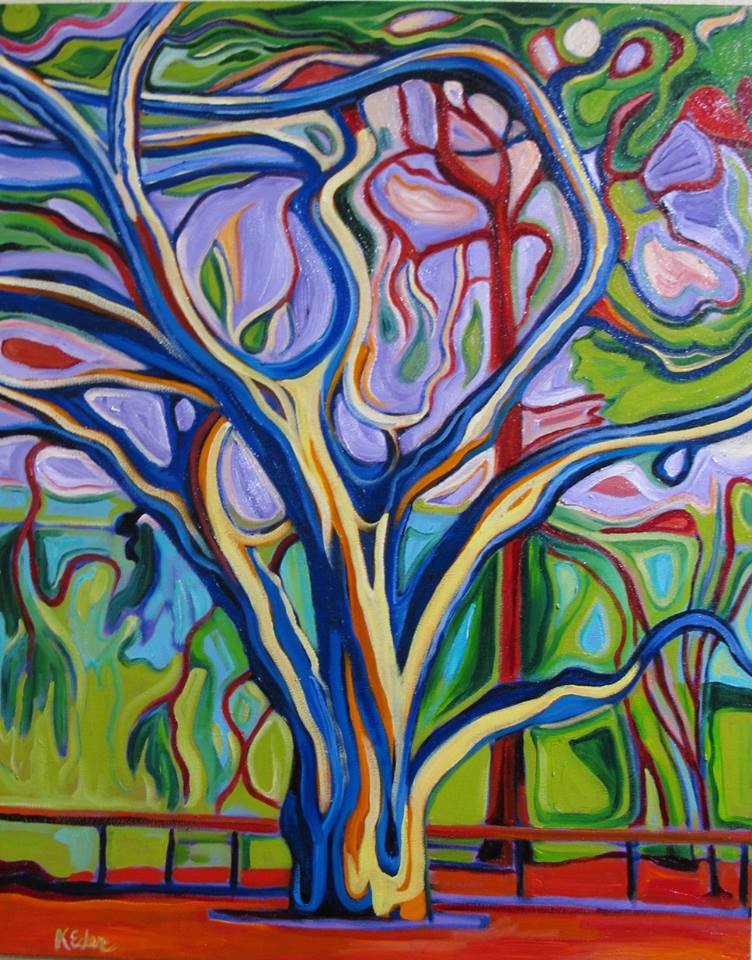
"Oak Tree," by Kikki Eder.
(click to enlarge) |
In other words, Eder doesn’t paint the tree. She paints the ecstatic thrill
she feels when she sees the tree. Consider a recent arboreal portrait,
almost drolly entitled “Oak Tree.” The trunk and limbs are four or five
shades of blue and cream and yellow and orange. We’re talking ochre and
powder blue and azure and touches of burnt sienna. The chaotic extremities
and background sky are lavenders and greens and aquas and scarlets that
mingle, but don’t mix, like coffee with unstirred cream. This is epiphany as
color.
Look how shockingly glorious everything really is. . .
“I love oak
trees,” she unassumes. “Each one has a story to tell, I'm sure. I wanted to
show the grace and poetry that that tree possesses. It was another painting
that turned into stream-of-consciousness.”
Or take
“Highland Park in the Fog.” A night street with parked cars and trees,
in Eder’s eye, is a roiling, phantasmagorical, liquid astonishment of
oranges, yellows, pinks, blacks, peach, aqua, pistachio. "Cloudy Day on the
L.A. River," aside from rendering a sterile electrical tower as something
lyrical, presents a pastoral L.A. where clouds and bushes and train swirl
and melt together. You almost hear Donovan singing "Everything's a part of
everything, anyway. . ." Her “Dusk
in Highland Park,” in my view, is the most effective evocation of a hot Santa
Ana wind night since Raymond Chandler wrote “Red Wind.” That spindly tree in
front of the little market has been rendered as a wind-whipped broken
geometry of purples and blue-blacks against a (probably moonlit) lapis
lazuli night. Scary, Halloweeny.
She is not a
one-trick wren, though. Some of the paintings lean toward the literal, such
as “On the Subway” (but those colors!) or “Painted Building,” where she lets
existing graffiti abstraction carry the interpretative impact. And “Alley in
East L.A.” elicits too often taken-for-granted architectural charm beneath
fabulous tinting. Everything is done in oil paint, by the way---none of that
wimpy acrylic stuff.
In a
world of tattooed cellulite, fuck-you traffic, thong panties, iPhone
suckling, general brutishness, Eder is, in person, an understatement.
Vaguely related to five-feet-tall, with hair that borrows equally from
blonde and gray, she has an easy, slight smile that suggests maybe the human
race is not terminally ill, after all. Of course it is, but when she puts on
her big sun hat and talks about how much she
loved visiting Japan, you remember that people can be endearing.
|
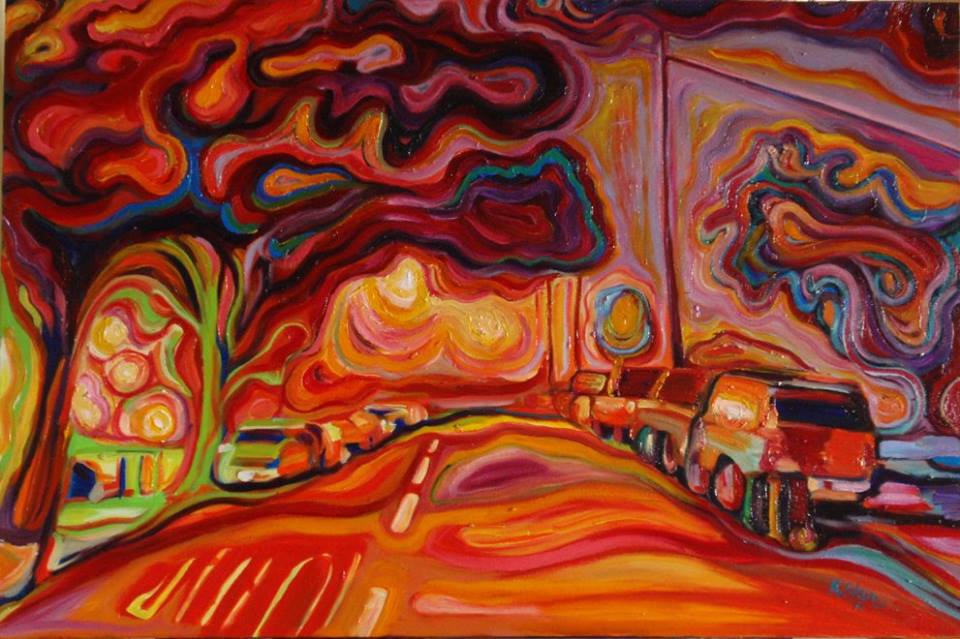
"Highland Park in Fog," by Kikki Eder.
(click to enlarge) |
“I love the Japanese aesthetic,” she says, eyes bright.“Every element
is balanced and necessary in all visual things, including food, packaging.
And they have a love for the cute and silly. If I were more immersed in
that culture I'm sure it would influence me, but I live in Highland Park as
a white, Jewish woman, which I think is enough of a mash-up. I was probably
influenced more by a trip I took to Guatemala in 1990. There, the people
live a life of art. It was incredible. They love color and it fills their
environment.”
Her
color-loving work is, significantly, about L.A.---the L.A. that rapacious
developers have so far ignored in their ongoing, 30-year greed festival,
wiping out lovely homes and gardens and driving up: housing prices, density,
congestion, pollution, acrimony. Eder’s focus: a mom-and-pop tienda,
an avenue of old Victorians and Craftsmen, parked cars, palms; a bus stop,
an unmemorable streetcorner, a barber shop. Certainly there are no
architecturally punishing condo hives, Uber-swarming Rodeo Drive sidewalks, “hipster” coffee
joints, direticulosis freeways.
“The
Los Angeles that most people think of is shiny buildings and pretty people,”
says Eder, who was Cecile until her older sister twisted it into “Kikki.”
“Those don't interest me. I like messy and complicated. I like interesting
and unusual. I like the storefronts with hand-painted lettering, brooms
hanging out in the doorway with real people standing around. It's a world
that's disappearing so I'm glad to capture it. I don't think the ordinary is
that ordinary. It's not corporate. It's real life lived by real people. I
appreciate this very much.”
So how Kikki Eder? She didn’t “inherit” painting talent, as her dad was a dentist with a strong musical streak (a sister,
Terry Eder, is a well-known concert pianist), and her mother
(who spent most of Kikki's childhood fighting cancer) had no proclivities
toward visual art. Has Eder been painting for five or
six decades, cannily waiting for developers to threaten fast-disappearing
L.A.? Hardly. The composer, Charles Ives, was an insurance agent. Eder is primarily a certified internal auditor. By way of
technical illustrator (1978-’90.) By way of gemology (She's a graduate
jeweler.)
“I don't remember having too many ambitions,” she said. “I
wanted to be an artist, but my mother thought I'd only be capable of
teaching art. I only wanted to go to art class. I read art books. In the 7th
grade I put myself into the 9th grade advanced art class. It took a couple
of months for them to figure out that I wasn't supposed to be in there, but
by then I was successfully doing the projects so they let me stay.”
At 17, she saw Picasso’s famed horror-of-war panorama,
“Guernica,” during her first visit to New York, and immediately “decided to
just get the hell out of suburban Detroit.” She wound up at Immaculate Heart
College in Hollywood, of all places, just a few years after the legendarily inspiring artist,
Sister Mary Corita Kent, but found the
obsession with conceptual art uninspiring.
|
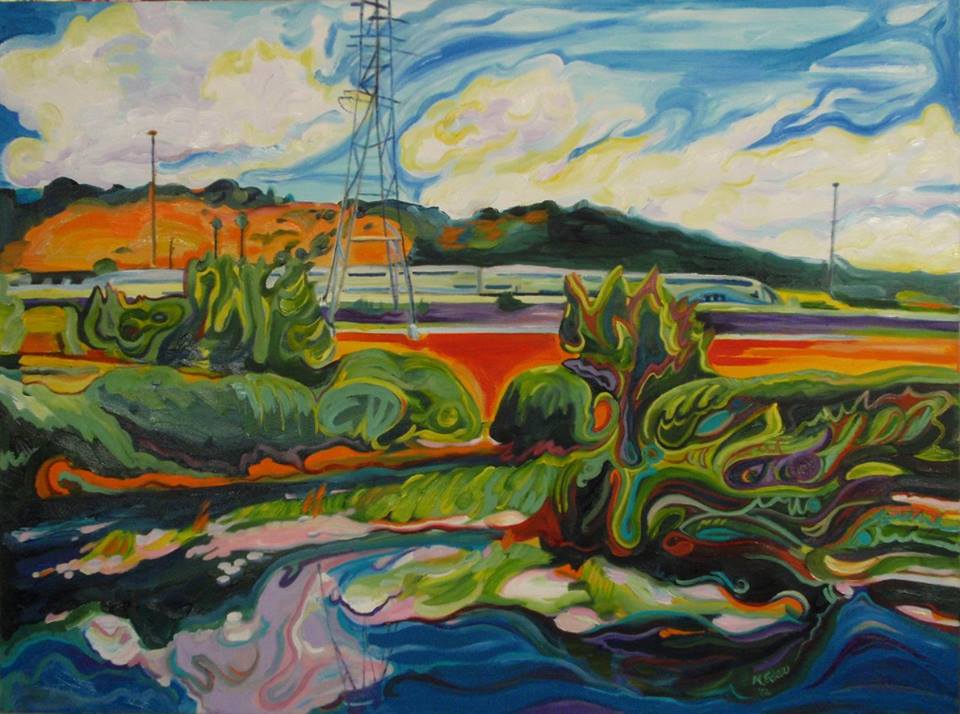
"Cloudy Day on the L.A. River," by Kikki Eder.
(click to enlarge) |
A transfer to San Diego City College proved fortuitous,
because a teacher named Frank Hunter made her believe she could create art
and make a living (imagine that) via technical illustration. And so she worked for various companies until
1990, when restlessness prompted her to enroll in the Gemological Institute
of Santa Monica, with the goal of setting up her own jewelry studio. Divorce
intervened, and she enrolled at CSUN to get a degree in accounting,
later working for Arthur Andersen and assorted hospitals.
So why, after
all that, did she
decide to paint? Mostly because "ordinary" L.A. caught her fancy, and that
she was quickly accepted in galleries in and around (pre-gentrified) Highland Park, her
home of 16 years. In what used to be common cultural
collusion in pre-ethnocentric Los Angeles, it was nice Jewish girl in the barrio “embraced by the
Latino artist community as one of their own”---beginning with the artist,
Margaret Garcia, who “introduced me to her circle and helped me to learn the
craft of painting.”
In the end, her success did not extend to
the politically
correct world of larger galleries and public art contracts. The larger
Latino art collections bypassed her, even when she was frequently showcased among Latino
artists (irony: the majority of art that she owns is by Latino/Latina
artists.) Three tries at getting a Metro Public Art contract went nowhere,
while certain artists were awarded second and third contracts.
“The art
selection process,” Eder said politely, “involves something I'm just not
privy to. It feels like a game and I got tired of playing. It is also well
known that women just don't seem to have the same opportunities that male
artists do. This is very apparent if one looks at the percentages of men
with exhibitions versus those of women. Often women are relegated to women's
shows. Sexism is alive and well in the art world.”
Which is to say, she is still not well known. Of course,
there are countless such “unknowns,” and many of them are painting L.A.
scenes, some very nicely. I haven’t seen a single one who paints with the
singularity of Eder. She should be the painter laureate of this
mixed-use-ravaged place, if they have such a thing. Never mind that her
output dropped in the last few years. Never mind that she is tired of
“playing the game” psychologically, and now, also physically. . .
About
five years ago, she was stricken with Lupus. A couple of months ago, she was
diganosed with Trigeminal Neuralgia, a painful nerve condition.
The plus side: she has not been run over by a truck.
“When I got sick, it took the joy out of life in many ways,”
she said. “I didn't feel inspired. I couldn't put my all into a painting
anymore. I don't have the same relationship to the world that I did."
|
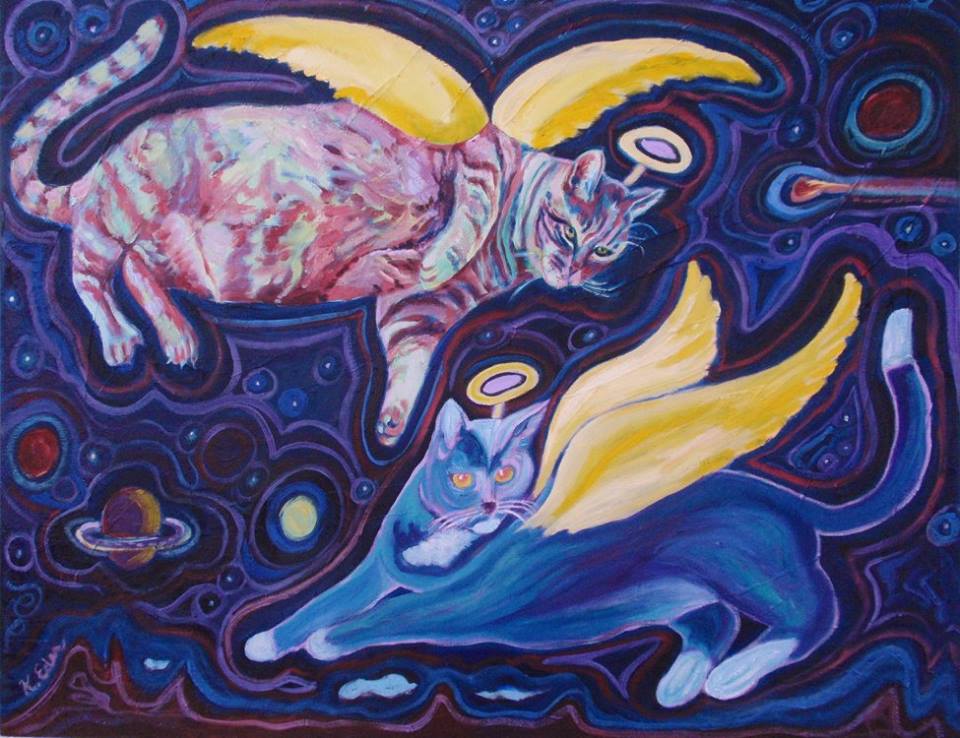
"Bunny and Csimpi in Heaven," by Kikki Eder.
(click to enlarge) |
Today, the paintings appear only when health permits.
“Oak Tree” is one such recent work, and one that shows her powers fully
intact, even if it can be a struggle to realize them. She will not, repeat
not, force the issue:
“I've
had to go through a grieving process," she said. "Something will emerge from this, but
it hasn't yet. I've tried to get the old feeling back, but it's not
something that I can force. When I force it, I can definitely see it in the
work. It's like a lie, something phony.”
Phony
is as far away from Eder’s ethos as humility is from Donald Trump. Most of
her paintings---which, happily, may be viewed on-line---are in private
collections, including one significant departure from L.A.-scapes: an
endearing, fanciful portrait of her longtime, now deceased roommates, the
cats Bunny and Csimpi (“in Heaven,” with angel wings, surrounded by stars
and planets.)
So there
it is, a thumbnail portrait of the best artist you’ve never heard of,
maybe, a woman who is telling anyone listening that the things you might not
notice are ravishingly beautiful, that “drab” and “ordinary” are myths, “routine”
a
dirty lie, and that corporations don’t sing like wrens.
“My painting
has expressed a lot of joy in just being,” said Kikki Eder. “It's been an
ode to life and a note of gratitude. They've been like my children in that
this is the legacy I'll be leaving behind.”
All images copyright Kikki (Cecile) Eder and used by
permission.
VIEW MORE KIKKI EDER PAINTINGS
BACK TO PAGE ONE |
![]() Riposte Archive
Riposte Archive